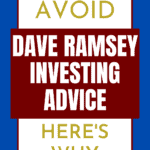THIS POST MAY CONTAIN AFFILIATE LINKS. PLEASE SEE MY DISCLOSURES. FOR MORE INFORMATION.
Are you feeling overwhelmed with the numerous investment options available?
Are you searching for a trustworthy and effective investment strategy to secure your financial future?
Look no further!
In this blog post, we will be exploring the investment path popularized by financial expert Dave Ramsey.
Whether you are a beginner in the world of investments or a seasoned investor looking for a fresh perspective, this article will provide invaluable insights and considerations to ponder before embarking on Ramsey’s investment journey.
We will delve into the pros and cons, potential risks, and crucial factors to evaluate when deciding if this investment path aligns with your financial goals and risk tolerance.
So grab a cup of coffee, relax, and let’s dive deep into this powerful investment strategy that has captured the attention of millions worldwide.
Table of Contents
#1. Load Mutual Funds

A big part of the Dave Ramsey investing philosophy is investing in load mutual fund investments.
Here is what he says on his website:
“Many investors hate the idea of paying around 5% of their investment for up-front commission. But because it’s a one-time expense, the value of your investment grows without being bogged down by expensive fees. And, as your investment increases in value over time, the commission has less impact on the overall cost of owning the fund.
Loaded funds also come with help—an investing professional. The commission pays for your pro’s extensive knowledge of the thousands of mutual funds available. The up-front commission is really not a lot to pay to have someone on your team, teaching you how to invest successfully.”
Note that there are two main types of mutual funds, load funds and no-load funds.
With a load mutual fund, you pay an investment fee upfront.
The fee you pay goes towards your investment advisor, which is how he earns his money.
Financial advisors who sell no-load mutual funds get paid by charging you a flat fee or a fee based on assets under management. This fee is usually around 1%.
The typical sales charge is 5.75% when investing in load mutual funds.
For every $100 you invest, $5.75 goes to the advisor, and you are investing the remaining $94.25.
And the money you invest gets charged the management fee of the mutual fund itself.
Here is why this is a bad idea.
You have $30,000 to invest into a load mutual fund for 25 years.
It is an actively managed fund, which charges 1.25% yearly as the management fee or expense ratio.
Your investment grows at 8% a year. How much do you have?
Of the $30,000 you invest, $1,725 goes to the advisor, and you invested the remaining $28,275. Your ending investment is $141,391.
But what if you invested in a no-load mutual fund that doesn’t charge any upfront fees?
We will assume the mutual fund charges a 0.50% management fee. Your investment would be worth $181,255.
That is a difference of over $20,000!
And before you think paying for a professionally managed fund is worth it, think again.
All mutual funds have professional management.
And the evidence shows that most active management mutual funds perform worse than passively managed index funds.
Don’t make the mistake that many other investors make, thinking that the more you pay for a mutual fund, the better it will perform.
When it comes to investing, the opposite is true. The less you pay, the more likely you will have higher returns.
How is this possible?
Because the money you pay in fees comes from the fund itself, these fees eat away at your ability to grow your wealth.
#2. Retirement Withdrawal Rate

The final piece of advice that Dave Ramsey gets wrong is the rate at which you can withdraw money from your retirement plan to live on.
He suggests an 8% withdrawal rate is acceptable.
Most retirement experts suggest only 4% is an acceptable withdrawal rate.
And some experts think you can’t follow a fixed withdrawal rate.
Let’s look at an example of these withdrawal rates to see how they play out.
We assume you have $1,000,000 saved and will be taking this money out starting at age 65.
As you take your money out, your investments will continue to grow at 8% annually.
By the time you reach 85 years of age taking 8% out from your portfolio annually, you end up with $800,000.
If you take 4%, at age 85, you have close to $2 million.
But this example doesn’t paint an accurate picture because the market fluctuates yearly.
When we look at these numbers in the real world, we see some scary numbers.
Here is the data from a monte-carlo simulation.
It takes 30 years periods from 1928-2020 to see the likelihood of you surviving retirement and not running out of money.
Using the 4% rule, you have a 1% chance of running out of money.
And in the worst-case scenario, you still have more than enough money than you started with!
But the numbers are very different if we look at an 8% withdrawal rate.
You have an 81% chance of running out of money.
And the best-case scenario, you have $5 million left.
I don’t like those odds. And neither should you.
You worked hard for your money and saved to enjoy your golden years.
Don’t let a foolish mistake cost you your dreams.
It would be best if you stuck with a lower withdrawal rate. Otherwise, chances are you will run out of money in retirement.
#3. The 12% Belief

Dave Ramsey claims that an investor can reasonably expect to earn 12% per year on their investments over the long term.
Sounds okay, but in reality, it is wrong.
His math is technically correct, but he is wrong about what will happen in the real world.
When calculating annual returns, he uses arithmetic to get to 12%.
Here is an example of this.
You invest $100 for two years. In the first year, your investment loses 50%. In the second year, your investment gains 100%. Your average rate of return is 25%.
As a result, your $100 should be worth $125, since your rate of return is 25% ($100 x 25% + $100).
But when you look at your account balance, you don’t have $125. You only have $100.
How is this? Let’s look at the numbers more closely.
You have $100, and in the first year, you lost 50%, or $50. You have a balance of $50 remaining.
In the second year, you earn a 100% return. A 100% return on your $50 is $50, so you end up with an ending balance of $100.
In those two years, you have earned 0% on your money.
This idea can be confusing, but this is how the stock market works. It uses compound annual growth, not average returns, which are misleading.
You might be wondering why this is a big deal.
Let’s use an example to help you understand it.
We have Bob, who expects a 12% return on his money. He makes $60,000 a year and saves 15% of his income, or $9,000. He saves for 30 years.
Based on Dave’s investing advice, he expects to have a nest egg at the end of the 30 years to be $2,432,633. But when he goes to retire, he finds that his balance is worth $1,000,389.
That’s a difference of close to $1.5 million dollars!
Mathematically there is nothing wrong with the 12% number Dave Ramsey is using. It is correct.
However, it is very misleading because it doesn’t consider the compounding of returns.
Assuming you can safely earn 12% annually, you are setting yourself up for great disappointment in retirement.
Most financial experts cite 6-8% as a reasonable return on your money, so you have realistic expectations.
#4. SmartVestor Pro

Related to the load mutual fund advice is Dave’s recommendation on advisors.
Years ago, if you wanted to work with a financial advisor who followed the Dave Ramsey investment philosophy, you went with one of his Endorsed Local Providers (ELP).
These financial and real estate professionals Dave promoted as the best in the business.
According to the Dave Ramsey website, they were held to a higher standard of excellence so that investors were treated right.
To be part of the ELP program, advisors had to pay a fee.
This fee covers employment costs and website maintenance.
In exchange for this fee, advisors were given referrals from the Dave Ramsey website, and they had territorial rights to their geographic area.
These rights meant no other advisor in their local area could be an ELP.
The advisors who joined the program had to follow the Dave Ramsey investment philosophy, selling investors front-loaded mutual funds.
Today the ELP program has been replaced by the SmartVestor Pro program.
This program is an advertising service where investors can connect with local advisors.
Advisors pay an advertising fee for a listing on the Dave Ramsey website.
Under this new program, advisors no longer have territorial rights.
Instead of getting one advisor for your local area, investors now get the names of multiple advisors.
The advisors have to compete for your business.
There is no confirmation as to why the ELP program ended. However, the change came when the Department of Labor proposed a new law regarding the fiduciary standard.
The basis behind the fiduciary standard is that an advisor must put their client’s interests ahead of their own, regardless of whether the advisor will make money.
Surprisingly to many investors, not all advisors do this.
If an advisor is not a fiduciary, and many advisors aren’t, they only have to invest your money in a suitable way.
In other words, let’s say there are two identical investments, and one charges a higher fee than the other.
An advisor that follows the fiduciary standard must put your money into the one with the lowest fee.
They must do what is best for you.
An advisor that does not follow the fiduciary standard is not required to put your money into the investment with the lowest fee.
They can choose either, as long as the investment suits you.
To be affiliated with Dave Ramsey, advisors in the SmartVestor Pro program pay Dave Ramsey an advertising fee.
The only other thing an advisor has to do is agree to a Code of Conduct.
While having a code of conduct is a step forward, it still isn’t good enough.
Instead of following the fiduciary standard, advisors affiliated with Dave Ramsey only need to follow the suitability standard and be registered with the Financial Industry Regulatory Authority (FINRA).
Following the suitability standard, they can still sell you high commission investments when a lower-cost option is available.
It is important to note that Dave Ramsey has been a vocal opponent of the fiduciary rule.
Dave Ramsey makes a mountain of money from the advertising fees advisors pay to be part of the now defunct ELP program and the new SmartVestor Pro program.
Just how much money?
The fee advisors pay ranges between $400 and $1,500 depending on many factors.
Say there are 1,400 advisors in the SmartVestor Pro program and each pay the minimum of $400 a month, this comes to $560,000 in fees Dave Ramsey earns.
Over a year, the earnings from the SmartVestor Pro fees come to $6,720,000!
#5. Asset Allocation

The next area of Dave Ramsey’s investing strategy that is misleading is asset allocation.
Diversifying your investment portfolio across many asset classes is key to long-term success.
But this isn’t the case with the investment advice Dave Ramsey gives his listeners.
He recommends you invest in 4 stock funds, 3 of which are roughly the same asset class.
By investing in growth, growth and income, and aggressive growth funds, you are investing in the same companies, just using different funds.
Investing this way does not diversify your risk.
You want to invest in different investments, like large-cap and small-cap companies.
For example, let’s look at a growth fund and a growth and income fund.
The top 10 holdings in the Vanguard Growth Index Fund (VIGAX) and the top 10 holdings in the Vanguard Growth and Income Fund (VQNPX), 40% are in both funds.
If we were to dig deeper, we would continue to see the overlap.
This overlap means you purchase the same stocks twice when you buy both funds.
It’s like buying a bottle of Coca-Cola and a bottle of Pepsi for a party.
Both are cola.
You are better off buying a bottle of Coca-Cola and a bottle of A&W Root Beer or Ginger Ale.
To be genuinely diversified in investing is to own various asset classes.
You need to own some combination of the following:
- Large cap stocks (both growth and value)
- Small cap stocks (both growth and value)
- International stocks (both large cap and emerging markets)
- Bonds (treasury, municipal, corporate)
- Commodities (oil, precious metals)
- Real estate
You don’t need to own something in each of these categories.
But, you should have exposure to more than just one, which is not what happens when you follow Dave Ramsey’s investing philosophy.
When fully diversified, you lower your overall risk and can still achieve a decent return.
But when you follow Dave Ramsey’s investing philosophy, you increase risk and don’t increase your return.
Educate Yourself

The more you understand about investing, the more likely you will succeed.
We are all stretched for time, but investing isn’t complicated.
It sounds complicated because there is a ton of information out there.
Just know that most of them are selling you something.
Diversify

You can’t be invested 100% in stocks and think you will never lose money.
On the flip side, you can’t be invested 100% in bonds and think your money will grow enough to allow you to retire comfortably.
You need a mix of both and some other asset classes as well.
Your Emotions Will Be Your Downfall

Almost every investor that fails does so because they give in to emotion.
They either get scared and sell when they shouldn’t, or they get greedy and buy when they shouldn’t.
Learn to control your emotions, use common sense, and you will see more success when it comes to investing.
Have A Plan

Having a plan when it comes to investing is critical to your success.
When times get tough (and they will), having a plan to remind yourself of why you are investing helps tremendously.
Start by investing your money in tax-advantaged investment accounts like 401k plans, a Traditional IRA, or a Roth IRA.
Then invest in a taxable account.
Investing in this manner will keep your taxes low, saving you money.
Pay Attention To Costs

Your fees eat into your returns, much more than most think.
Understand how fees work and what you pay, not just today but over 30 or more years.
Also, look into mutual funds and ETFs as your core holdings.
By investing in suitable mutual funds, you can cut back on management costs by a lot.
Also, stay away from individual stocks, at least for now.
Investing in single stocks requires a lot more research and monitoring on your end.
Remember that all mutual funds and ETFs have professional management.
Focus On The Long-Term

Related to your emotions is your time horizon.
Most people look at the market over the short term, and the volatility scares them.
But if you pull back and look at things over the long term, you will see things aren’t so bad.
The market will be jumpy in the short term, but over the long term, the trend is positive.
How You Should Be Investing Your Money

Now that you see the issues with Dave Ramsey’s investing advice, how do you invest your money?
I know you follow Dave’s advice because he is a trusted source, and investing is overwhelming with all the investment choices.
So why should you listen to me?
I’ve been in the financial services industry for close to 15 years and have worked with investors with millions to invest.
All along the way, I was a fiduciary and always put the client first.
I’ve been investing since the late 1990s and have grown my wealth to over seven figures using a buy-and-hold investing approach.
And I’ve helped friends, family, and readers of this site grow their wealth by working with them one-on-one.
You can grow your investment wealth without a financial advisor, and you don’t need to be paying loads on mutual funds to invest.
You can do it all yourself with just a little hand holding.
A great option is Charles Schwab.
They have Intelligent Portfolios that automate investing for you.
You enter your goals, and Schwab will invest your money for you.
There are no advisor fees and no trading fees.
If you do want some hand holding from a financial planner, you can pay $300 for a one-time planning fee and then $30 a month with their Premium service.
How Much Money Will You Save?

If you decide to invest on your own instead of with a SmartVestor Pro, here is how much money you will save.
If you invest $24,000 for 20 years, you end up with close to $110,000 by investing on your own.
But if you do with a SmartVestor Pro, you end up with less than $82,000.
As you can see, the fees you pay to invest make a massive difference over time.
That’s a difference of $26,000!
Investing Basics To Learn

Regardless of the route you decide to take, you should educate yourself on the basics when it comes to investing.
Not only will it help you make smarter decisions with your money, but it will also help you save money and grow your wealth more consistently.
Here are some key things to remember to be a successful investor.
Become a Stock Market Millionaire

Do you want to know how to invest and build wealth?
Here is a step-by-step guide to help you do just that.
HOW TO BECOME A STOCK MARKET MILLIONAIRE
Is VTSAX A Good Investment?

Many people consider investing in the Vanguard fund VTSAX.
But is it s good investment or right for you? Here is what you need to know.
Investing Basics You Need to Know

Investing can feel complicated but it’s really not.
If you simply learn a few of the basics, you can be successful in the stock market.
Here is what you need to know.
How Investing $250 A Month Makes You A Millionaire

Most people think they need a lot of money to invest.
But the reality is, if you can invest just $250 a month, you can become a millionaire.
Here are the steps to make it a reality.
HOW TO INVEST $250 A MONTH MAKES YOU A MILLIONAIRE
How To Start Over Financially At 50

It can be difficult to start over financially at any age.
But when you are 50, there is added pressure. Not only do you have a limited number of working years left, but you also see how well others in your peer group are doing.
If you are starting over at 50, don’t give up hope. Here is how to drastically improve your finances.
HOW TO START OVER FINANCIALLY AT 50
I have over 15 years experience in the financial services industry and 20 years investing in the stock market. I have both my undergrad and graduate degrees in Finance, and am FINRA Series 65 licensed and have a Certificate in Financial Planning.
Visit my About Me page to learn more about me and why I am your trusted personal finance expert.

